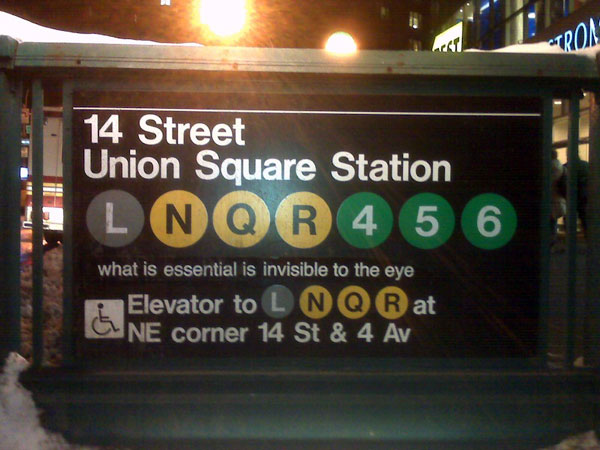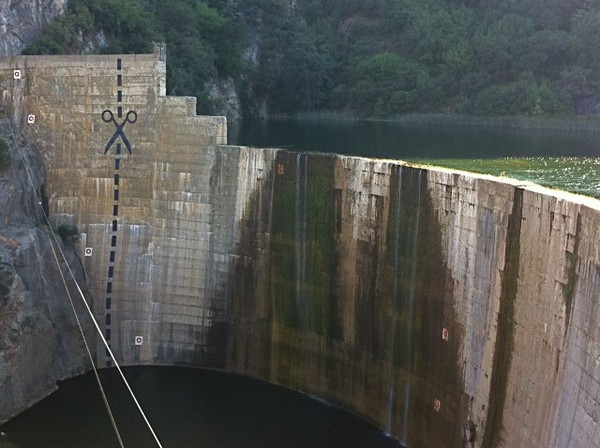graffiti
Tahrir, Revolution, and Design
Stunning photos today of the millions of Egyptians out in the streets to commemorate the start of the revolution a year ago that turned out Mubarak — and to demand transition from military to civilian rule.
A few things have been written on the supporting role of design in the revolution and the urban landscape as both site and medium of protest:
- The role
of protest signage
- Graffiti and murals
- Planning, public squares and cities as tools of rebellion
- Flyers, manifestos and ephemera
- Cellphone cameras and social media
- Even product labeling.
But I think my favorite detail is in this annotated overview of Tahrir square by BBC News.
The authors of direct action (particularly in West Asia and North Africa) are often depicted as a rowdy mob of thugs. But instead of the usual sea of angry Arab men so often shown by the mainstream media, the photo shows a kindergarten set up in the square. Schools in Cairo had been closed during the protests, but many mothers wanted to attend the demonstration as well. So demonstrators organized an impromptu kindergarten.
The image captures the spirit of mutual support that sprang up around the occupation. And my favorite detail: the newsprint under the paintings to keep the square, the city and country they love, free from spills. No random acts of violence here, but using the city to create something new, a different future, with hope and love.
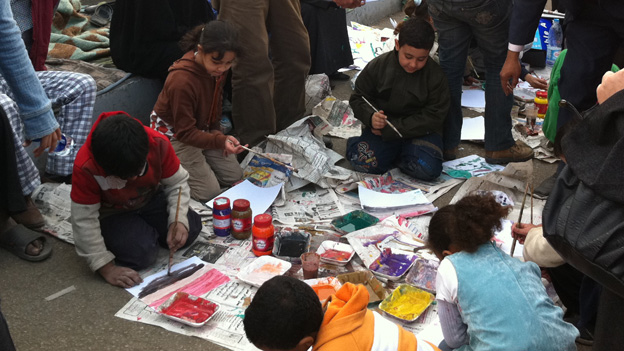
What is Essential
Political Graffiti
All graffiti have their politics but some more explicitly call for public policy change. Here are a few interesting pieces I’ve run into in the last week. An effective mix of surprise and cheek.
A portrait of Troy Davis wheatpasted to the sides of a fence in London for Amnesty International UK, protesting his then pending execution in Georgia. More »
Residents, environmentalists and officials want to tear down an obsolete dam near Ojai. After years of protest, a band of artists used creative tactics to call attention to the issue. The image appeared on the front page of the local paper the same day environmentalists, county officials, and the Army Corps of Engineers met to discuss the dam. More »
A nice bit of information design. (Via)
Bricks and Mortars

While the conflict in Israel and Palestine is a war for dominance, territory, hearts and minds, it is also a war on, and of, the built environment: bulldozing and bombing homes, laying and rerouting roads, checkpoints, the separation wall, and, of course, the settlements.
After the Israeli assault on Gaza that began in December 2008, the Israeli army banned the import of cement. This is particularly pressing since homes, hospitals, schools, water networks cannot be rebuilt.
While some are designing around the ban, developing mud brick architecture and off-grid lighting systems, other activists have flouted the ban sending Gaza cement themselves. And though Israel eased a total ban on construction materials in late July, only 41 truckloads of construction materials were allowed to enter Gaza in 2009. Thousands more are needed.
Last week, on the anniversary of the assault, a group of sixteen human rights and humanitarian organizations accused the international community of betraying the people of Gaza by failing to end the Israeli blockade. Meanwhile, the Western media has not only ignored demonstrations within Israel and without, but even softened the impact of the blockade.
Update 1/6/10: Al Jazeera has another angle on design, the blockade, and the built environment: a write-up of graffiti culture in Gaza. Without access to uncensored news, some activists have turned to graffiti — and were even occasionally sponsored, supplied, and trained by Hamas or Fatah. (via)

Neo Gardenism
At the intersection of urbanism, DIY, food justice and sustainable agriculture, a crop of artists are making open source gardens and sharing instructions on the web and beyond.
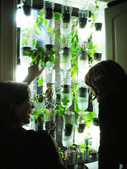 Britta Riley and Rebecca Bray build hydroponic Window Farms from recycled materials. The farms are specifically designed with New York City apartments in mind, and the website invites window gardeners to share photos, plans, designs and information.
Britta Riley and Rebecca Bray build hydroponic Window Farms from recycled materials. The farms are specifically designed with New York City apartments in mind, and the website invites window gardeners to share photos, plans, designs and information.
Edible Estates is a project to convert the classic American front lawn into a productive vegetable garden. Initiated by architect and artist Fritz Haeg on Independence Day, 2005, several prototype gardens were created in different cities across the United States, with instructions and documentation of the prototype gardens posted to the site. 2009 sites have not been announced, but the group is ideally looking for “A monotonous housing development of identical homes... where the interruption of the endless lawn would be dramatic and controversial.”
The Future Farmers’ Victory Gardens project is fought on two fronts: to deliver urban garden kits to urban farmers across San Francisco, and to ultimately develop and maintain a portion of the original Victory Garden space in San Francisco’s Golden Gate Park.
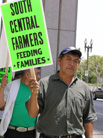 The Garden is a feature-length documentary film about a 14-acre community garden in South Central Los Angeles that emerged in the wake of the 1992 LA riots. The film chronicles the origins of the plot and the South Central Farmers struggle to prevent it from being demolished.
The Garden is a feature-length documentary film about a 14-acre community garden in South Central Los Angeles that emerged in the wake of the 1992 LA riots. The film chronicles the origins of the plot and the South Central Farmers struggle to prevent it from being demolished.
On the more underground tip, Guerilla Gardening is illicit, nocturnal gardening in a space not your own. guerrillagardening.org lists projects, mostly in London, each with a description, location, photos, and budget. The site includes tips for making your own.

Seed bombing is packing seeds in compressed soil and throwing it into inhospitable or hard to reach places. Artist Liz Christy was the first to use the term in 1973 when she fought urban decay by tossing seed grenades full of sunflower seeds into abandoned New York City lots. Here’s a scan of her original instruction sheet. Christy also co-founded the first community garden in New York City.
 Moss graffiti is also good for damp, urban corners. Anna Garforth has done some beautiful work here. Here’s how to make your own.
Moss graffiti is also good for damp, urban corners. Anna Garforth has done some beautiful work here. Here’s how to make your own.
And onto Gardening 2.0: Landshare is a UK website matching people who want to grown their own food with homeowners with underused space. The site also hosts an active forum for sharing tips and answering questions.
And with your veggies in hand, VeggieTrader is a website for trade, buy or sell homegrown produce.
I’m sure there are many more sites and projects, too. Between the recession and growing concern about industrial food systems, there seems to be something of a renaissance going on here.
Letter to the Editor
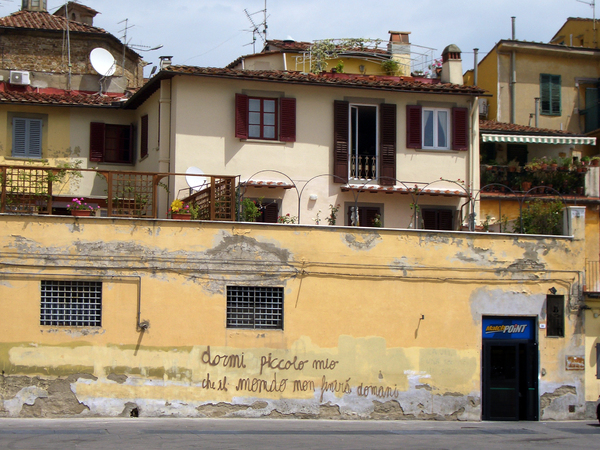
“Sleep my little one, for the world will not end tomorrow.”
Graffito in the piazza in front of the offices of La Nazione, a popular newspaper in Florence. Based on the layers of paint on the wall, it seems graffiti is a popular feedback loop here.
I’m here for the excellent Più design può. More notes soon.
Via Just Seeds I found this condescending story in the LA Times. But it’s interesting nonetheless: “Baret, who like his fellow insurgents is a veteran defendant, had refused to pay the $58 fine. His lawyer argued that his actions were less destructive than the 57,000 giant signs that fill the train stations of France.... ‘The advertising budget in France is $39 billion a year.... That’s equivalent to the entire education budget in France.... Our movement goes a lot further than a simple symbolic gesture. And that’s what we want the public to understand.’”
This two-pronged attack on aggressive advertising, fighting with both graffiti and law, seems to be a growing pattern, a combination of legal and extra-legal civil disobedience (with a dash of spectacle) in the battle over what constitutes public space.
Linkbox
A few collections of wonderful things:
- Political street art mostly related to the U.S. presidential election
- Anti-war stencils, a Flickr group
- Activist images and posters from around the world in the traveling Propaganda III exhibition


